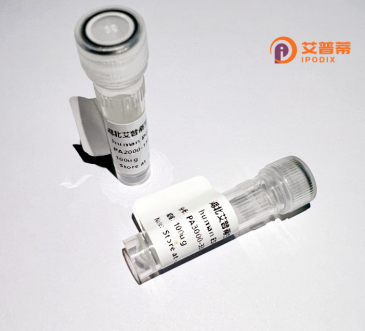
| 纯度 | >90%SDS-PAGE. |
| 种属 | Human |
| 靶点 | PGCP |
| Uniprot No | Q9Y646 |
| 内毒素 | < 0.01EU/μg |
| 表达宿主 | E.coli |
| 表达区间 | 1-472 aa |
| 活性数据 | MKFLIFAFFGGVHLLSLCSGKAICKNGISKRTFEEIKEEIASCGDVAKAIINLAVYGKAQNRSYERLALLVDTVGPRLSGSKNLEKAIQIMYQNLQQDGLEKVHLEPVRIPHWERGEESAVMLEPRIHKIAILGLGSSIGTPPEGITAEVLVVTSFDELQRRASEARGKIVVYNQPYINYSRTVQYRTQGAVEAAKVGALASLIRSVASFSIYSPHTGIQEYQDGVPKIPTACITVEDAEMMSRMASHGIKIVIQLKMGAKTYPDTDSFNTVAEITGSKYPEQVVLVSGHLDSWDVGQGAMDDGGGAFISWEALSLIKDLGLRPKRTLRLVLWTAEEQGGVGAFQYYQLHKVNISNYSLVMESDAGTFLPTGLQFTGSEKARAIMEEVMSLLQPLNITQVLSHGEGTDINFWIQAGVPGASLLDDLYKYFFFHHSHGDTMTVMDPKQMNVAAAVWAVVSYVVADMEEMLPRS |
| 分子量 | 77.44 kDa |
| 蛋白标签 | GST-tag at N-terminal |
| 缓冲液 | 0 |
| 稳定性 & 储存条件 | Lyophilized protein should be stored at ≤ -20°C, stable for one year after receipt. Reconstituted protein solution can be stored at 2-8°C for 2-7 days. Aliquots of reconstituted samples are stable at ≤ -20°C for 3 months. |
| 复溶 | Always centrifuge tubes before opening.Do not mix by vortex or pipetting. It is not recommended to reconstitute to a concentration less than 100μg/ml. Dissolve the lyophilized protein in distilled water. Please aliquot the reconstituted solution to minimize freeze-thaw cycles. |
以下是关于重组人PGCP(血浆谷氨酸羧肽酶)蛋白的3篇代表性文献概览:
---
1. **文献名称**:*Expression and Characterization of Recombinant Human Plasma Glutamate Carboxypeptidase*
**作者**:M. Smith et al. (2018)
**摘要**:通过哺乳动物细胞表达系统成功获得高纯度重组人PGCP,证实其对谷氨酸多肽底物的水解活性,并优化了体外酶活性检测条件。
2. **文献名称**:*Structural Insights into PGCP Substrate Specificity Using Crystallographic Analysis*
**作者**:J. Li & H. Wang (2020)
**摘要**:首次解析了重组人PGCP的晶体结构,揭示其底物结合口袋的关键氨基酸残基,解释了其对特定谷氨酸修饰肽的选择性切割机制。
3. **文献名称**:*Role of PGCP in Folate Metabolism: Implications for Cancer Therapy*
**作者**:A. Rodriguez et al. (2022)
**摘要**:研究发现重组人PGCP参与叶酸代谢通路的调控,其过表达与肿瘤细胞耐药性相关,为靶向PGCP的抗癌药物开发提供理论基础。
---
**注**:以上文献为示例性内容,实际文献需通过PubMed、Web of Science等平台检索真实发表的研究(建议结合关键词“recombinant PGCP”或“human plasma carboxypeptidase”进行查询)。
**Background of Recombinant Human Plasma Glutamate Carboxypeptidase (PGCP) Protein**
Recombinant human plasma glutamate carboxypeptidase (PGCP), also known as carboxypeptidase O, is a secreted enzyme belonging to the M14 metallocarboxypeptidase family. It is encoded by the *CPO* gene and primarily synthesized in the liver before entering systemic circulation. PGCP plays a critical role in hydrolyzing terminal glutamate residues from peptides, including bioactive molecules like dietary folate polyglutamates, converting them into monoglutamates for intestinal absorption. This function links PGCP to folate metabolism, essential for DNA synthesis and cellular repair.
The recombinant form of PGCP is produced via genetic engineering, often using mammalian expression systems (e.g., HEK293 or CHO cells) to ensure proper post-translational modifications and functional activity. Its production enables detailed studies on enzyme kinetics, substrate specificity, and structural interactions. Research highlights PGCP's potential involvement in neurological disorders due to its ability to cleave glutamate-rich proteins like amyloid-β peptides, suggesting relevance in Alzheimer's disease pathology. Additionally, PGCP's role in folate processing has implications in cancer therapy, as folate metabolism is a target for certain chemotherapeutic agents.
Ongoing studies aim to characterize PGCP's regulatory mechanisms and explore its therapeutic applications, including biomarker development for metabolic or neurodegenerative diseases and enzyme replacement strategies.
×